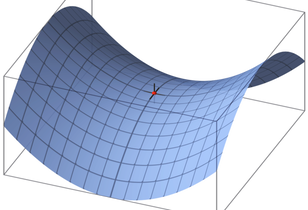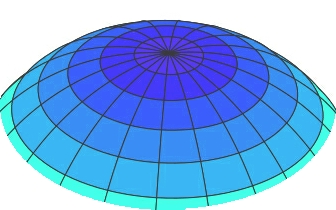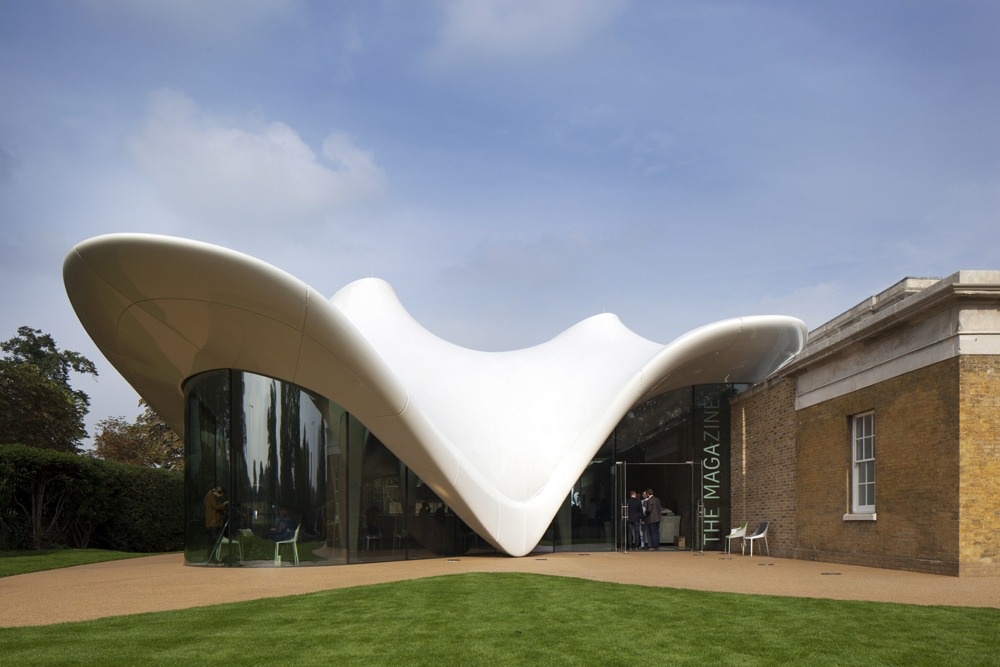Anticlastic structures
Tensile surfaces, that is, surfaces which carry only tension and no compression or bending, rely on double curvature for their stability. Stability is provided by the opposition of two curvatures which enable the surface to be tensioned without losing its form.
Tensioning the surface reduces its elasticity and so its tendency to deform under load, and the curvature itself means that the surface will deform less for any given extension.
Tensile surfaces can be used in buildings to create thin, long span enclosures, such as roofs for sports stadia, shopping centres, atria and so on. Typically they are constructed using a PVC coated polyester or PTFE coated glass fabric, typically just 1 mm thick.
Double curvature can be anticlastic or synclastic.

|

|
| Anticlastic (saddle-shaped). | Synclastic (dome-shaped) |
Anticlastic surfaces are those in which the centres of curvature are located on opposing sides of the surface. This is commonly-described as a saddle shape. A hyperbolic paraboloid is an anticlastic surface.
Synclastic surfaces are those in which the centres or curvature are on the same side of the surface. This is a dome-shape. This can be created with an architectural fabric by inflation – that is, air pressure within the dome maintains the form of the surface when it is tensioned, rather than the opposition of the curvatures.
[edit] Find out more
[edit] Related articles on Designing Buildings Wiki
- Barrel vault.
- Biaxial bending.
- Concept structural design of buildings.
- Conoid shell.
- Fabric structures.
- Hyperbolic paraboloid.
- Limit state design.
- Millennium Dome.
- Structural engineer.
- Synclastic.
- Tensegrity.
- Tensile structures.
- The development of structural membranes.
- The structural behaviour of architectural fabric structures.
- Types of dome.
[edit] External references
- ‘How structures work: Design and behavior from bridges to buildings’ (2nd ed.), YEOMANS, D., Wiley (2016)
Featured articles and news
International Electrician Day, 10 June 2025
Celebrating the role of electrical engineers from André-Marie Amperè, today and for the future.
New guide for clients launched at Houses of Parliament
'There has never been a more important time for clients to step up and ...ask the right questions'
The impact of recycled slate tiles
Innovation across the decades.
EPC changes for existing buildings
Changes and their context as the new RdSAP methodology comes into use from 15 June.
Skills England publishes Sector skills needs assessments
Priority areas relating to the built environment highlighted and described in brief.
BSRIA HVAC Market Watch - May 2025 Edition
Heat Pump Market Outlook: Policy, Performance & Refrigerant Trends for 2025–2028.
Committing to EDI in construction with CIOB
Built Environment professional bodies deepen commitment to EDI with two new signatories: CIAT and CICES.
Government Grenfell progress report at a glance
Line by line recomendation overview, with links to more details.
An engaging and lively review of his professional life.
Sustainable heating for listed buildings
A problem that needs to be approached intelligently.
50th Golden anniversary ECA Edmundson apprentice award
Deadline for entries has been extended to Friday 27 June, so don't miss out!
CIAT at the London Festival of Architecture
Designing for Everyone: Breaking Barriers in Inclusive Architecture.
Mixed reactions to apprenticeship and skills reform 2025
A 'welcome shift' for some and a 'backwards step' for others.
Licensing construction in the UK
As the latest report and proposal to licence builders reaches Parliament.
Building Safety Alliance golden thread guidance
Extensive excel checklist of information with guidance document freely accessible.
Fair Payment Code and other payment initiatives
For fair and late payments, need to work together to add value.
Pre-planning delivery programmes and delay penalties
Proposed for housebuilders in government reform: Speeding Up Build Out.
High street health: converting a building for healthcare uses
The benefits of health centres acting as new anchor sites in the high street.

























